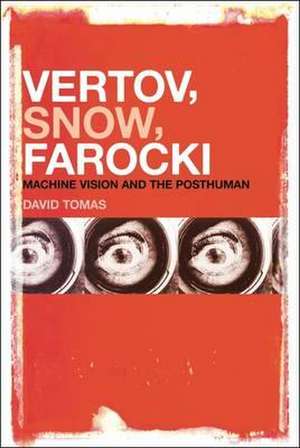Vertov, Snow, Farocki: Machine Vision and the Posthuman
Autor David Tomasen Limba Engleză Hardback – 23 oct 2013
| Toate formatele și edițiile | Preț | Express |
|---|---|---|
| Paperback (1) | 259.34 lei 6-8 săpt. | |
| Bloomsbury Publishing – 22 apr 2015 | 259.34 lei 6-8 săpt. | |
| Hardback (1) | 774.62 lei 6-8 săpt. | |
| Bloomsbury Publishing – 23 oct 2013 | 774.62 lei 6-8 săpt. |
Preț: 774.62 lei
Preț vechi: 990.94 lei
-22% Nou
Puncte Express: 1162
Preț estimativ în valută:
148.29€ • 154.14$ • 122.95£
148.29€ • 154.14$ • 122.95£
Carte tipărită la comandă
Livrare economică 08-22 februarie 25
Preluare comenzi: 021 569.72.76
Specificații
ISBN-13: 9781441169150
ISBN-10: 1441169156
Pagini: 304
Ilustrații: 60 bw illus
Dimensiuni: 152 x 229 x 25 mm
Greutate: 0.57 kg
Ediția:New.
Editura: Bloomsbury Publishing
Colecția Bloomsbury Academic
Locul publicării:New York, United States
ISBN-10: 1441169156
Pagini: 304
Ilustrații: 60 bw illus
Dimensiuni: 152 x 229 x 25 mm
Greutate: 0.57 kg
Ediția:New.
Editura: Bloomsbury Publishing
Colecția Bloomsbury Academic
Locul publicării:New York, United States
Caracteristici
Interdisciplinary approach incorporates film and media studies, technology studies, art and visual culture, and new media
Notă biografică
David Tomas is a Professor at the School of Visual Arts, University of Quebec, Montreal, Canada.
Cuprins
Introduction Part I: Threshold: When a Ritual Process Speaks of Machine Vision and Cyborg Prototypes: A Film Document, Circa 1929 Chapter 1. Manufacturing Vision and the Posthuman Circa 1929: Kino-eye, The Man with a Movie Camera, and the Perceptual Reconstruction of Social Identity Part II: Enigma of the Central Region: A Microhistory of Machine Vision and Posthuman Consciousness, Circa 1969-1972Chapter 2. La Région Centrale: Basic Cultural, Technical and Formal Filiations. Chapter 3. Toward a Cosmic Rite of Passage: External & Internal Locations and a Play of Authorship Chapter 4. La Région Centrale: Liminality, Knowledge Production, Pedagogy. Chapter 5. La Région Centrale: From Cosmic to Posthuman Rite of Passage Chapter 6. De La (1969-71): Authorship, Automation and the Posthuman. Chapter 7. A Comparative Schematic Analysis of the Automated Narrative and its Mechanical Logic in Vertov's The Man with a Movie Camera (1929) and Michael Snow's De La (1969-1972). Part III The Public Deployment of Machine Vision and the Programmed Materialization of the Posthuman in Collective Social Space, Two Early Twenty-First Century Video Documents Chapter 8. A Posthuman Future in the Age of the Algorithm: Farock's Documentation of the Operational Image and its Culture of Surveillance BibliographyIndex
Recenzii
Tomas, an artist and anthropologist at the Université du Québec, Montréal, continues the work he undertook in Beyond the Image Machine: A History of Visual Technologies (CH, Dec'04, 42-2261), exhorting readers to view visual technologies differently. In this volume, Tomas attempts to shift attention from aesthetic products to ritual practices. Specifically, he argues for understanding the mechanical process of filming as a rite of passage whereby the image is taken, processed, and reincorporated into the socio-symbolic order. This ritual structure becomes the basis for a comparative anthropological study of Dziga Vertov's The Man with a Movie Camera, Michael Snow's La Région Centrale and De La, and Harun Farocki's trilogy Eye/Machine and Counter-Music. The experimental, posthuman processes involved in shooting these unique films is of primary interest, leading to detailed discussions of the filmmaker's intentions and abstract theorization of their specific execution. For this reason, Tomas's esoteric, though intriguing, revisioning of ilm's history and future is likely of most use to experts. Summing Up: Recommended. Graduate students, researchers, faculty.
